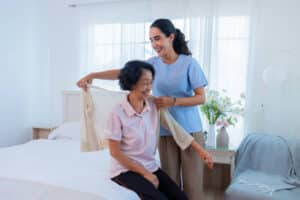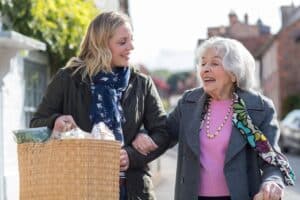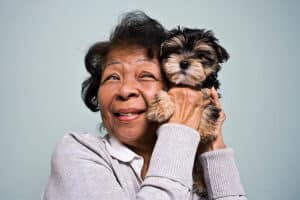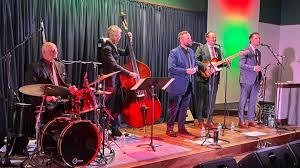
Getting dressed each morning connects deeply to our sense of self. The clothes we choose express personality, comfort preferences, and how we want others to see us. For someone living with dementia, this everyday task gradually becomes more challenging, yet maintaining control over personal appearance remains meaningful.
As memory and processing skills change, thoughtful assistance with dressing becomes essential. The right support preserves dignity while easing frustration. With some creative adjustments, dressing time can become less stressful and more successful for everyone involved.
Practical Approaches for Easier Dressing
Label Storage Areas Clearly
Make closets and drawers easier to navigate by adding visual markers. Simple pictures paired with basic words help identify where items belong. A sock image on the sock drawer or a shirt picture on the shirt drawer creates visual shortcuts that bypass memory challenges.
These markers reduce the need to remember where things are stored and help maintain independence longer.
Set Up Clothes in Order
Place clothing on a solid-colored bed or chair in the exact sequence needed—underwear first, followed by pants or skirt, then shirt, and finally sweater or jacket.
Prepare each piece before offering it—unfold items, open buttons, unzip zippers, and make sure everything is right-side out. Give clear, one-step directions when needed: “Put your arm through this sleeve” works better than complex instructions.
Limit Clothing Choices
Too many options can overwhelm someone with dementia. Instead of access to a full wardrobe, select a handful of complete outfits that work well together.
When asking for preferences, offer just two options: “The blue shirt or the red one?” This maintains choice without creating decision fatigue. Keep these selected clothes easily accessible in a designated area.
Take Your Time
Rushing creates tension. Build extra time into morning routines specifically for dressing. Moving at a relaxed pace makes a tremendous difference in reducing stress.
Focus on the process rather than perfect results. Mismatched socks or a crooked button rarely matter in the bigger picture of comfort and autonomy.
Honor Unusual Choices
When unusual outfit combinations appear, ask whether they truly need correction. The desire to wear a favorite shirt frequently or match unexpected colors represents continuing self-expression.
Respect these choices whenever possible. Comfort and personal preference matter more than conventional matching, provided the clothing is appropriate for weather conditions and basic safety.
Create Style Reference Points
Photographs showing preferred outfits, hairstyles, and accessories help everyone remember established preferences. These visual reminders prove especially helpful when multiple family members or caregivers provide assistance.
Visual guides maintain consistency and respect long-standing style choices that might otherwise get overlooked.
Use Adaptable Layers
Lightweight, removable layers work better than single heavy garments. This approach accommodates temperature sensitivity and allows for easy adjustment as needed.
A t-shirt, button-up shirt, and cardigan offer more flexibility than one thick sweater. This strategy prevents complete outfit changes while maintaining comfort throughout the day.
Handle Clothing Changes Tactfully
When clothes need changing, focus on positive aspects: “This clean shirt feels nice” rather than pointing out stains or odors.
For beloved items that rarely leave rotation, consider buying identical replacements. This allows one to be washed while the other stays in use—maintaining comfort while addressing hygiene needs.
Optimize the Environment
The setting matters tremendously. Ensure the room stays warm enough, has good lighting without harsh glare, and remains free from distractions.
Consider privacy preferences and bathroom access before starting. These seemingly small details often determine whether dressing proceeds smoothly or becomes distressing.
Select Practical, Familiar Clothing
When buying new clothes, balance style with function. Look for front-opening designs, elastic waistbands, larger buttons, or hook-and-loop closures that simplify dressing.
New items that closely resemble long-time favorites typically gain acceptance more easily than completely different styles.
Address Sensory Comfort
Many people with dementia develop heightened sensitivity to fabrics, seams, tags, or tight clothes. What once felt fine might now cause distress.
Remove itchy tags, choose soft fabrics, and watch for signs of discomfort like tugging at clothing. Cotton breathes better than many synthetics. Pay special attention to undergarments, which contact sensitive skin directly.
Adapt as Abilities Change
Dressing support needs adjustment as dementia progresses. Early on, labeled drawers and simplified choices work well. Later, laying out clothes in sequence helps. Eventually, more hands-on assistance becomes necessary.
Breaking tasks into smaller steps helps maintain participation regardless of ability level. Someone who can no longer dress independently might still manage to pull up pants once positioned or push arms through sleeves when guided.
Memory Care Facilities and Support
In memory care facilities, caregivers are trained to assist with daily dressing routines while maintaining dignity and independence. These environments are designed to support individuals with varying stages of dementia, offering personalized assistance that aligns with the specific needs of each person. Support in these settings helps preserve autonomy and self-expression through everyday tasks like getting dressed.
These continuing contributions matter tremendously for maintaining dignity. The goal remains consistent: supporting maximum independence possible at each stage, with genuine respect guiding every interaction.
Supporting someone through dressing challenges requires creativity and flexibility. What works well today might need adjustment tomorrow as abilities shift. By focusing on the person rather than just completing a task, dressing time transforms from a potential struggle into an opportunity for maintaining dignity and connection.









